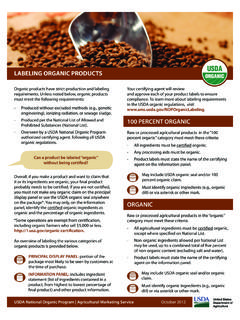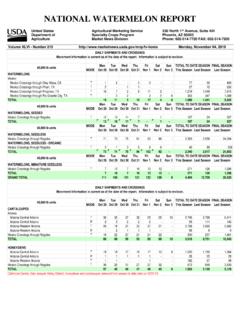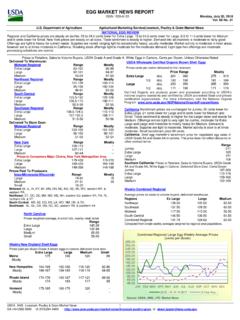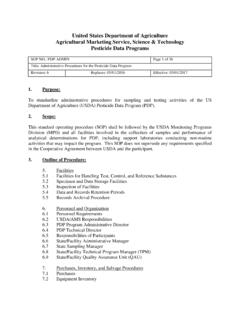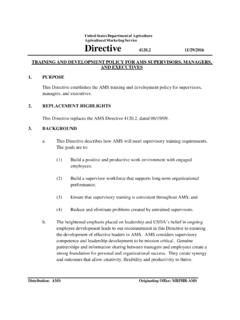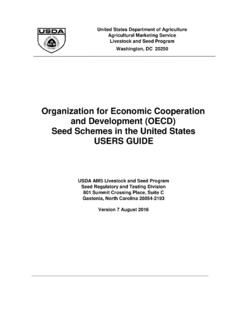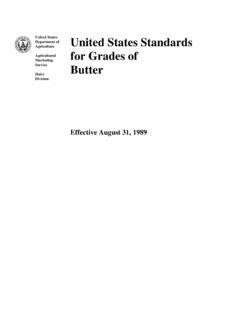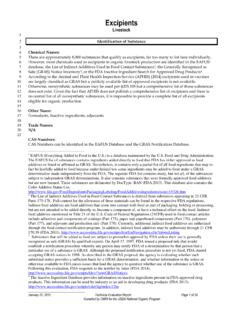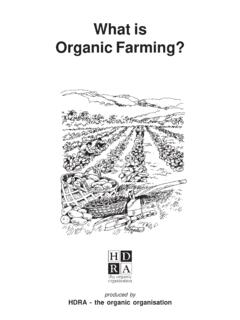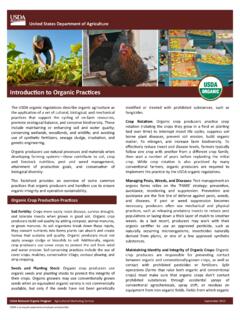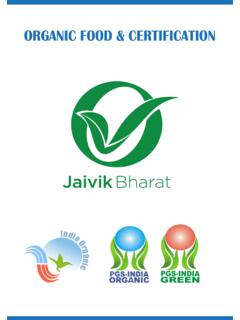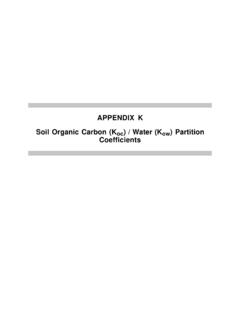Transcription of Guide for Organic Crop Producers
1 Guide for Organic Crop ProducersBy Pamela Coleman National Center for Appropriate Technology (NCAT) Agriculture SpecialistNovember 2012 ContentsCHAPTER 1 INTRODUCTIONNew farmers, and farmers experienced in conventional agriculture, often find that obtaining Organic certification for their crops is quite challenging. This Guide is intended to help lead farmers through the Organic certification process. Chapters 1 through 4 explain the National Organic Program (NOP) and describe the process of Organic certification. Later chapters explain specific USDA Organic regulations that apply to planting, soil fertility, pest management, and other farm practices. In addition to inter-preting the regulations, this Guide explains the practices and materials that are allowed for Organic should read this Guide ? Conventional farmers who are considering Organic certification for their crops. Farmers in the process of converting to Organic practices. Farmers who are new to Organic certification.
2 Farmers who are exempt from certification because they sell less than $5,000 of Organic produce per year. Extension personnel and other information Guide was designed to be read before completing an application for Organic certifica-tion. This is not a required document; it is a helpful Guide that you may use as you wish. How to use this guideTo be certified Organic by the Department of Agriculture (USDA), farms must be managed in accordance with the regulations in Title 7, Part 205 of the Code of Federal Regulations. Where the USDA Organic seal appears, the text quotes from these Federal regulations. The verbatim text of the regulation language follows the section and paragraph (for example, ). The verbatim text is followed by an explanation of the 1 Introduction ..1 Chapter 2 Organic Agriculture Description and History ..3 Chapter 3 The Certification Process ..7 Chapter 4 Writing the Organic System Plan (OSP).
3 13 Chapter 5 Soil Fertility ..18 Chapter 6 Seeds and Planting Stock ..25 Chapter 7 Crop Rotation ..29 Chapter 8 Managing Pests, Weeds, and Diseases ..32 Chapter 9 The National List of Allowed and Prohibited 10 Greenhouse Production ..43 Chapter 11 Preventing Contamination of Organic Crops ..46 Chapter 12 Post-Harvest and Labeling ..50 Chapter 13 Recordkeeping ..54 Chapter 14 Structural Pest 15 Resources ..61 This Guide uses the term USDA Organic regulations to refer to the United States Federal regulations that govern Organic crop production, livestock production, handling, processing, and labeling. Different terminology is often used in other publications to refer to the same regulations: National Organic Standards, NOP Final Rule, or simply standards, Rules, or requirements are common examples. In this Guide , some of the section titles in the regulations are referred to as standards to correspond with the actual text for example, Seeds and planting stock practice standard.
4 The term standard is also commonly used in relationship to the National Organic Stan-dards Board (NOSB). The NOSB is a citizen advisory board that helps the Department of Agriculture (USDA) determine which substances and practices may be used in certified Organic production and handling. However, these recommendations are not part of the USDA Organic regulations until the USDA decides the appropriate regulatory direction after completing a formal review and receiving public Guide for Organic Crop ProducersPage 2 The book icon indicates publications available from ATTRA-National Sustainable Agri-culture Information Service. ATTRA provides farmers and educators with information about sustainable agriculture via toll-free helplines, an extensive Web site, and hundreds of publications. These publications can be downloaded from the ATTRA Web site, or you can call the ATTRA helpline to request a print copy.
5 ATTRA s Web site is Its English-language helpline number is 800-346-9140; the Spanish-language helpline number is useful resources can be found at the end of this icon indicates resources that are available on the Internet. This icon precedes the questions at the end of each chapter. The questions serve as a checklist to help you evaluate your farm s eligibility for Organic certification and identify areas where your practices may need to be each of the questions carefully and place a check in the appropriate Yes, No, or Not Applicable box. Answers that accurately reflect your current circumstances will be the most helpful to you. Ideally, most of your checks will be in the Yes boxes. Negative answers may indicate a need to modify your farm practices to comply with the you have questions about whether a particular practice or product is allowed in Organic production, consult a certifying agent. This icon at the end of a chapter indicates a place where you can add your own notes.
6 Notes Guide for Organic Crop Producers 3 CHAPTER 2 Organic AGRICULTURE DESCRIPTION AND HISTORYThe origins of Organic farmingContemporary American Organic farming has its roots in the humus farming move-ments that spread across Great Britain and continental Europe from the 1920s through the 1950s. These movements evolved largely in response to the increasing use of synthetic fertilizers and pesticides. The proponents of humus farming believed that the highest quality food and the sustainability of agriculture were achieved by feeding the soil, thereby building soil fertility. Their goal was to increase the humus the fully decom-posed Organic matter that has reached a stable state in the soil. Humus farming was typified by mixed farms that included livestock, food crops, feed crops, and green manures. Humus farming made little or no use of soluble commercial fertilizers or pesticides, in part because the health of the soil rendered them unnecessary.
7 The 1960s and 1970s brought more visibility to Organic farming in the United States, as public concern over pesticide use increased. In the minds of consumers, the non-use of pesticides was an important part of Organic agriculture. The growth of the Organic industry during this era led to the establishment of standards and third-party certifica-tion. Third-party certification is an assessment process carried out to verify compliance with standards. It involves the producer (farmer), the consumer (buyer), and a third party the certifying agent who affirms that the product is produced in accordance with the Organic regulations. As the Organic industry expanded during the 1980s, different certifiers developed their own standards and certification processes. As a result, some certifiers did not accept the valid-ity of Organic certification by other certifiers. These disparities among certifier standards resulted in barriers to trade, which led many to believe that a consistent set of standards was needed: a single set of standards for Organic production, labeling, and market-ing.
8 Eventually, Congress passed the Organic Foods Production Act (OFPA) of 1990. This act mandated creation of the National Organic Program (NOP), which is part of the Department of Agriculture (USDA) and the National Organic Standards Board (NOSB). The NOSB is an advisory board of 15 volunteers: Organic Producers (farmers) Organic handlers (processors) Retailers Environmentalists Scientists Consumer advocatesAfter the NOSB makes a recommendation on a new regulation or standard, there is a review and comment period. The NOP then determines the appropriate regulatory action to carry forward. In addition to the setting of standards (rulemaking), the accreditation of Organic certifiers and the enforcement of the regulations are important tasks of the NOP. The def inition of organicWith regulation came the need for more formal definitions of the term Organic . In 1995, the NOSB defined Organic agriculture as an ecological production management system that promotes and enhances biodiversity, biological cycles, and soil biological activity.
9 Related ATTRA publications Organic Program Compliance Checklist for ProducersOrganic Standards for Crop Production: Highlights of the USDA s National Organic Program Guide for Organic Crop ProducersPage 4In 2002, the NOP defined Organic agriculture: Organic production [is] a production system [s] to site-specific conditions by integrating cultural, biological, and mechanical practices that foster cycling of resources, promote ecological balance, and conserve biological diversity [ ].This definition conveys both what makes each Organic farm unique and all Organic farms alike. Each farm is unique because farmers must make management decisions based on the singular conditions found in their own operations. Soil types, crop varieties, fertility requirements, pest pressures no two Organic farmers will manage all the variables that impact their farms the same way. Nor will changes in annual conditions such as rainfall and frost date allow an Organic farmer to operate the same way year in and year out.
10 Each season, Organic farmers encounter a one-of-a-kind set of natural resource and environmen-tal conditions to which they must adapt and respond. Organic agriculture as a production system Both definitions of Organic agriculture above describe Organic agriculture as a produc-tion system. This systems approach strives to understand how all parts of the system work together. In a systems approach, the farmer will consider how soil, water, plants, animals, insects, bacteria, fungi, and all other parts of the system can interact to cause problems or prevent them. The farmer s management toolkit combines three types of techniques: cultural ( , planting disease-resistant varieties); biological ( , pheromone traps); and mechanical ( , appro-priate tillage). Organic farmers combine these practices into a productive management system that minimizes the impact to the off- farm environment. All Organic farmers share this approach, though their specific objectives determine how they implement its beginning, Organic agriculture has also been based on the principle of sustain-ability.
